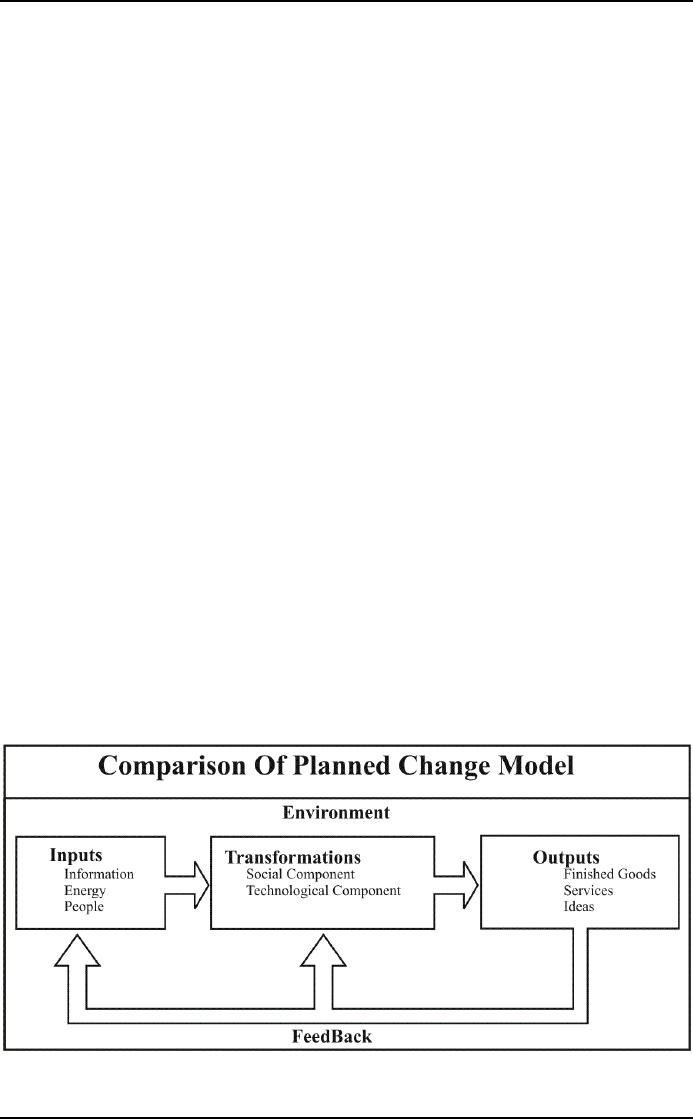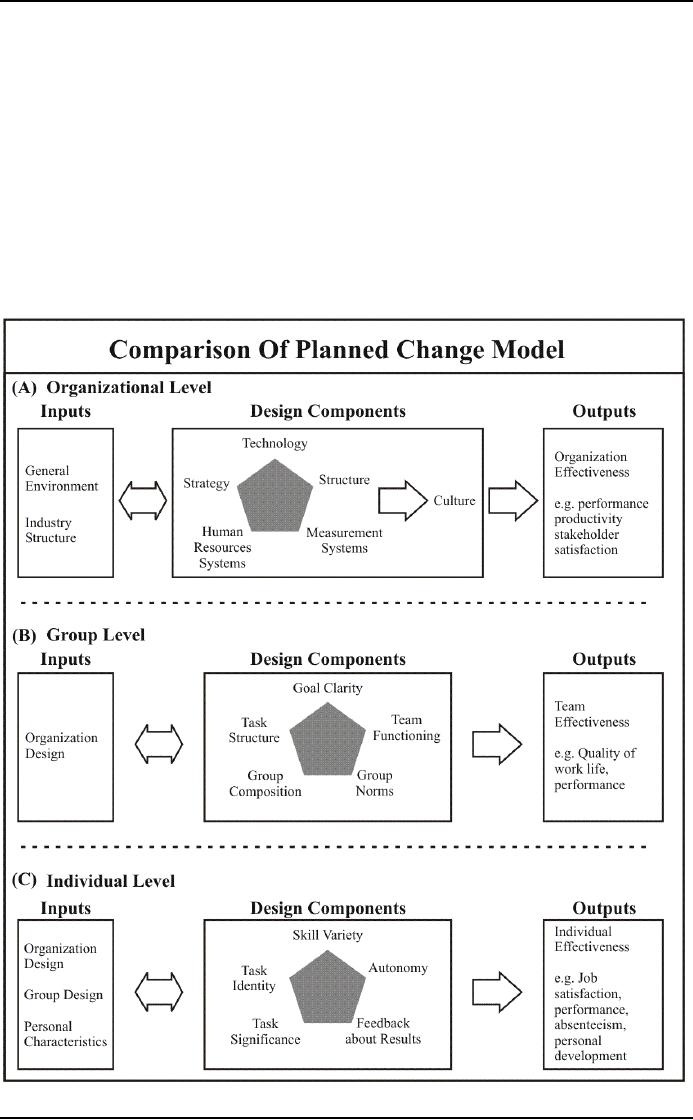 |

Organization
Development MGMT
628
VU
Lesson
16
Organization
as Open Systems
Systems
can vary in how open they are to
their outside environments. Open
systems, such as
organizations
and
people, exchange information
and resources with their
environments. They cannot completely
control
their
own behavior and are
influenced in part by external forces.
Organizations, for example,
are affected
by
such environmental conditions as the
availability of raw material,
customer demands, and
government
regulations.
Understanding how these external forces
affect the organization can help explain
some of its
internal
behavior.
Open
systems display a hierarchical ordering.
Each higher level of system comprises
lower-level systems:
systems
at the level of society comprise
organizations; organizations comprise
groups (departments);
and
groups
comprise individuals. Although
systems at different levels vary in
many ways--in size
and
complexity,
for example--they have a number of common
characteristics by virtue of being open
systems,
and
those properties can be applied to
systems at any level. The
following key properties of open
systems
are
described below: inputs, transformations, and outputs;
boundaries; feedback; equifinality;
and
alignment.
Inputs,
Transformations, and Outputs:
Any
organizational system is composed of
three related parts: inputs,
transformations, and outputs, as
shown
in Figure 21. Inputs consist of
human or other resources,
such as information, energy,
and materials,
coming
into the system. Inputs are
acquired from the system's external
environment. For example,
a
manufacturer
in organization acquires raw materials
from an outside supplier. Similarly, a hospital
nursing
unit
acquires information concerning a
patient's condition from the attending
physician. In each case,
the
system
(organization or nursing unit) obtains resources
(raw materials or information)
from its external
environment.
Transformations
are the processes of converting
inputs into outputs. In organizations, a
production or
operations
function composed of both
social and technological components
generally carries out
transformations.
The social component consists of people
and their work
relationships, whereas the
technological
component involves tools, techniques, and
methods of production or service
delivery.
Organizations
have developed elaborate mechanisms
for transforming incoming resources
into goods and
services.
Banks, for example, transform
deposits into mortgage loans
and interest income. Schools
attempt
to
transform students into more
educated people. Transformation
processes also can take
place at the
group
and individual levels. For
example, research and development
departments can transform the
latest
scientific
advances into new product
ideas.
Outputs
are the results of what is transformed by the
system and sent to the
environment. Thus,
inputs
that
have been transformed represent outputs
ready to leave the system.
Group health insurance
companies
receive
premiums, healthy and unhealthy individuals,
and medical bills, transform them through
physician
visits
and record keeping, and
export treated patients and
payments to hospitals and
physicians.
Fig
21: The Organization as an Open
System
Boundaries:
The
idea of boundaries helps to distinguish
between systems and environments.
Closed systems have

Organization
Development MGMT
628
VU
relatively
rigid and impenetrable boundaries,
whereas open systems have
far more permeable
borders.
Boundaries--the
borders, or limits, of the system--are
easily seen in many
biological and
mechanical
systems.
Defining the boundaries of social
systems is more difficult
because there is a continuous
inflow
and
outflow through them. For
example, where are the organizational
boundaries in this case? When a
fire
alarm
sounds in Malmo, Sweden, a
firefighter puts the address of the
fire into a computer terminal. A
moment
later, the terminal gives out a description of
potential hazards at the address.
The computer storing
the
information is in Cleveland, Ohio.
The emergence of the information
superhighway and
worldwide
information
networks will continue to challenge the
notion of boundaries in open
systems.
The
definition of a boundary is somewhat
arbitrary because a social
system has multiple
subsystems and the
boundary
line for one subsystem
may not be the same as that
for a different subsystem. As
with the system
itself,
arbitrary boundaries may
have to be assigned to any
social organization, depending on the variable
to
be
stressed. The boundaries
used for studying or analyzing
leadership, for instance,
may be quite
different
from
those used to study
intergroup dynamics.
Just
as systems can be considered relatively
open or closed, the permeability of boundaries
also varies from
fixed
to diffuse. The boundaries of a community's police
force are probably far more
rigid and sharply
defined
than those of the community's political
parties. Conflict over
boundaries is always a
potential
problem
within an organization, just as it is in the
world outside the organization.
Feedback:
As
shown in Figure 21, feedback is
information regarding the actual
performance or the results of the
system.
Not all such information is
feedback, however. Only information
used to control the
future
functioning
of the system is considered feedback.
Feedback can be used to maintain the
system in a steady
state
(for example, keeping an assembly
line running at a certain
speed) or to help the organization adapt
to
changing
circumstances. McDonald's, for
example, has strict feedback
processes to ensure that a
meal in
one
outlet is as similar as possible to a
meal in any other outlet. On
the other hand, a salesperson in
the
field
may report that sales
are not going well
and may insist on some
organizational change to improve
sales.
A market research study may
lead the marketing department to recommend a
change to the
organization's
advertising campaign.
Equifinality:
In
closed systems, a direct cause-and-effect
relationship exists between the initial
condition and the
final
state
of the system: when a computer's "on"
switch is pushed, the system
powers up. Biological and
social
systems,
however, operate quite differently.
The idea of equifinality
suggests that similar
results may be
achieved
with different initial
conditions and in many
different ways. This concept
suggests that a
manager
can
use varying degrees of inputs
into the organization and can transform
them in a variety of ways to
obtain
satisfactory outputs. Thus, the function
of management is not to seek a
single rigid solution
but
rather
to develop a variety of satisfactory options.
Systems and contingency theories
suggest that there is
no
universal
best way to design an organization.
Organizations and departments providing
routine services,
such
as AT&T's and MCIWorldCom's long
distance phone services could be
designed quite differently
and
still
achieve the same result. Similarly,
customer service functions at major
retailers, software
manufacturers,
or
airlines could be designed according to
similar principles.
Alignment:
A
system's overall effectiveness is
determined by the extent to which the different
parts are aligned
with
each
other. This alignment or fit concerns the
relationships between inputs and transformations,
between
transformations
and outputs, and among the
subsystems of the transformation process.
Diagnosticians
who
view the relationships among the various
parts of a system as a whole
are taking what is referred to as
a
systemic perspective.
Alignment
refers to a characteristic of the relationship
between two or more parts.
It represents the extent
to
which the features, operations,
and characteristics of one
system support the effectiveness of
another
system.
Just as the teeth in two `wheels of a
watch must mesh perfectly
for the watch to keep time, so
do
the
parts of an organization need to mesh
for it to be effective. For example,
General Electric attempts to
achieve
its goals through a strategy
of diversification, and a divisional
structure is used to support
that
strategy.
A functional structure would
not be a good fit with the
strategy because it is more
efficient for one
division
to focus on one product line
than for one manufacturing department to
try to make many
different
products.
The systemic perspective
suggests that diagnosis is the
search for misfits among the
various parts
and
subsystems of an organization.
Diagnosing
Organizational Systems:

Organization
Development MGMT
628
VU
When
viewed as open systems, organizations
can be diagnosed at three
levels. The highest level is
the
overall
organization and includes the design of
the company's strategy, structure,
and processes. Large
organization
units, such as divisions, subsidiaries, or
strategic business units, also
can be diagnosed at
that
level.
The next lowest level is the
group or department, which
includes group design and
such devices for
structuring
interactions among members as norms
and work schedules. The
lowest level is the individual
position
or job. This includes ways in
which jobs are designed to
elicit required task
behaviors.
Diagnosis
can occur at all three
organizational levels, or it may be
limited to issues occurring at a
particular
level.
The key to effective diagnosis is to
know what to look for at
each level as well as how the
levels affect
each
other. For example,
diagnosing a work group
requires knowledge of the variables
important for group
functioning
and how the larger organization
design affects the group. In fact, a
basic understanding of
organization-level
issues is important in almost
any diagnosis because they
serve as critical inputs to
understanding
groups and
individuals.
Figure
22 presents a comprehensive model for
diagnosing these different organizational
systems. For each
level,
it shows: (1) the inputs
that the system has to work
with, (2) the key design
components of the
transformation
subsystem, and (3) the
system's outputs.
Fig
22: Comprehensive Model for
Diagnosing Organizational
Systems

Organization
Development MGMT
628
VU
The
relationships shown in Figure 22 illustrate
how each organization level affects the
lower levels. The
larger
environment is an input to organization
design. Organization design is an input
to group design,
which
in turn serves as an input to
job design. These
cross-level relationships emphasize
that organizational
levels
must fit with each
other if the organization is to operate
effectively. For example,
organization
structure
must fit with and
support group task design,
which in turn must fit with
individual job
design.
The
following discussion on organization-level
diagnosis and the future
discussion on group- and
job-level
diagnosis
provide a general overview of the
dimensions (and their relationships)
that needs to be
understood
at each level. It is beyond the scope at this
stage to describe in detail the many
variables and
relationships
reported in the extensive literature on organizations.
However, specific diagnostic
questions
are
identified and concrete
examples are included as an introduction
to this phase of the planned
change
process.
Organization-Level
Diagnosis:
The
organization level of analysis is the broadest
systems perspective typically
taken in diagnostic
activities.
The
model shown in Figure 22(A) is similar to
other popular organization-level
diagnostic models.
These
include
Weisbord's six-box model, Nadler
and Tushman's congruency model,
Gaibraith's star model,
and
Kotter's
organization dynamics model. Figure 22(A)
proposes that an organization's
transformation
processes,
or design components, represent the
way the organization positions and
organizes itself
within
an
environment (inputs) to achieve specific
outputs. The combination of design
component elements is
called
a strategic orientation.
Inputs:
To
understand how a total organization
functions, it is necessary to examine particular
inputs, design
components,
and the alignment of the two sets of
dimensions. Figure 22 shows that
two key inputs affect
the
way an organization designs its
strategic orientation: the general
environment and industry
structure.
The
general environment represents the
external elements and forces
that can affect the attainment of
organization
objectives. It can be described in
terms of the amount of uncertainty present in
social,
technological,
economic, ecological, and
political forces. The more
uncertainty there is in how the
environment
will affect the organization, the more
difficult it is to design an effective
strategic orientation.
For
example, the technological environment in the
watch industry has been
highly uncertain over time.
The
Swiss,
who build precision watches
with highly skilled craftspeople,
were caught off guard by the
mass
production
and distribution technology of Timex in
the 1960s. Similarly, many watch
manufacturers were
surprised
by and failed to take
advantage of digital technology. Similarly, the
increased incidence of
AIDS
in
the workplace (social environment) and
the passage of the Americans with
Disabilities Act (political
environment)
have forced changes in the strategic
orientations of organizations.
An
organization's industry structure or task
environment is another important input
into strategic
orientation.
As defined by Michael Porter, an
organization's task environment consists
of five forces:
supplier
power, buyer power, threats of
substitutes, threats of entry,
and rivalry among competitors.
First,
strategic
orientations must be sensitive to
powerful suppliers who can
increase prices (and therefore
lower
profits)
or force the organization to pay more
attention to the supplier's needs
than to the organization's
needs.
For example, unions represent
powerful suppliers of labor
that can affect the costs of
any
organization
within an industry. Second,
strategic orientations must be sensitive
to powerful buyers.
Airplane
purchasers, such as American Airlines or
country governments, can force
Airbus Industries or
Boeing
to lower prices or appoint the
planes in particular ways. Third,
strategic orientations must be
sensitive
to the threat of new firms entering into
competition. Profits in the restaurant
business tend to be
low
because of the ease of starting a new
restaurant. Fourth, strategic
orientations must be sensitive to
the
threat
of new products or services
that can replace existing offerings.
Ice cream producers must
carefully
monitor
their costs and prices
because it is easy for a
consumer to purchase frozen
yogurt or other types
of
desserts
instead. Finally, strategic orientations
must be sensitive to rivalry
among existing competitors. If
many
organizations are competing for the
same customers, for example,
then the strategic orientation
must
monitor
product offerings, costs, and
structures carefully if the organization is to survive
and prosper.
Together,
these forces play an important
role in determining the success of an organization,
whether it is a
manufacturing
or service firm, a nonprofit
organization, or a government agency.
General
environments and industry structures
describe the input content. In addition
to understanding
what
inputs are available, the inputs
must be understood for their
rate of change and
complexity. An
organization's
general environment or industry structure
can be characterized along a
dynamic--static
continuum.
Dynamic environments change rapidly and
unpredictably and suggest that the
organization
adopt
a flexible strategic orientation. Dynamic
environments are relatively high in uncertainty.
The
complexity
of the environment refers to the number of
important elements in the general
environment and
industry
structure. For example,
software development organizations face
dynamic and complex

Organization
Development MGMT
628
VU
environments.
Not only do technologies,
regulations, customers, and
suppliers change rapidly,
but all of
them
are important to the firm's survival. On
the other hand, manufacturers of
glass jars face more
stable
and
less complex environments.
Table of Contents:
- The Challenge for Organizations:The Growth and Relevance of OD
- OD: A Unique Change Strategy:OD consultants utilize a behavioral science base
- What an “ideal” effective, healthy organization would look like?:
- The Evolution of OD:Laboratory Training, Likert Scale, Scoring and analysis,
- The Evolution of OD:Participative Management, Quality of Work Life, Strategic Change
- The Organization Culture:Adjustment to Cultural Norms, Psychological Contracts
- The Nature of Planned Change:Lewin’s Change Model, Case Example: British Airways
- Action Research Model:Termination of the OD Effort, Phases not Steps
- General Model of Planned Change:Entering and Contracting, Magnitude of Change
- The Organization Development Practitioner:External and Internal Practitioners
- Creating a Climate for Change:The Stabilizer Style, The Analyzer Style
- OD Practitioner Skills and Activities:Consultant’s Abilities, Marginality
- Professional Values:Professional Ethics, Ethical Dilemmas, Technical Ineptness
- Entering and Contracting:Clarifying the Organizational Issue, Selecting an OD Practitioner
- Diagnosing Organizations:The Process, The Performance Gap, The Interview Data
- Organization as Open Systems:Equifinality, Diagnosing Organizational Systems
- Diagnosing Organizations:Outputs, Alignment, Analysis
- Diagnosing Groups and Jobs:Design Components, Outputs
- Diagnosing Groups and Jobs:Design Components, Fits
- Collecting and Analyzing Diagnostic information:Methods for Collecting Data, Observations
- Collecting and Analyzing Diagnostic information:Sampling, The Analysis of Data
- Designing Interventions:Readiness for Change, Techno-structural Interventions
- Leading and Managing Change:Motivating Change, The Life Cycle of Resistance to Change
- Leading and managing change:Describing the Core Ideology, Commitment Planning
- Evaluating and Institutionalizing Organization Development Interventions:Measurement
- Evaluating and Institutionalizing Organization Development Interventions:Research Design
- Evaluating and Institutionalizing Organization Development Interventions
- Interpersonal and Group Process Approaches:Group Process
- Interpersonal and Group Process Approaches:Leadership and Authority, Group Interventions
- Interpersonal and Group Process Approaches:Third-Party Interventions
- Interpersonal and Group Process Approaches:Team Building, Team Building Process
- Interpersonal and Group Process Approaches:Team Management Styles
- Organization Process Approaches:Application Stages, Microcosm Groups
- Restructuring Organizations:Structural Design, Process-Based Structures
- Restructuring Organizations:Downsizing, Application Stages, Reengineering
- Employee Involvement:Parallel Structures, Multiple-level committees
- Employee Involvement:Quality Circles, Total Quality Management
- Work Design:The Engineering Approach, Individual Differences, Vertical Loading
- Performance Management:Goal Setting, Management by Objectives, Criticism of MBO
- Developing and Assisting Members:Career Stages, Career Planning, Job Pathing
- Developing and Assisting Members:Culture and Values, Employee Assistance Programs
- Organization and Environment Relationships:Environmental Dimensions, Administrative Responses
- Organization Transformation:Sharing the Vision, Three kinds of Interventions
- The Behavioral Approach:The Deep Assumptions Approach
- Seven Practices of Successful Organizations:Training, Sharing Information